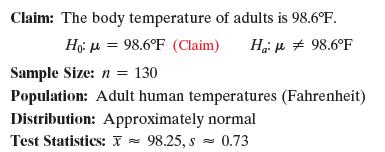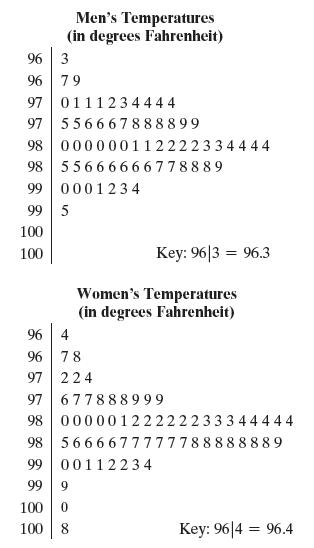In an article in the Journal of Statistics Education (vol. 4, no. 2), Allen Shoemaker describes a
Question:
In an article in the Journal of Statistics Education (vol. 4, no. 2), Allen Shoemaker describes a study that was reported in the Journal of the American Medical Association (JAMA).* It is generally accepted that the mean body temperature of an adult human is 98.6°F. In his article, Shoemaker uses the data from the JAMA article to test this hypothesis. Here is a summary of his test.

* Data for the JAMA article were collected from healthy men and women, ages 18 to 40, at the University of Maryland Center for Vaccine Development, Baltimore.

Questions
1. Complete the hypothesis test for all adults (men and women) by performing the following steps.
Use a level of significance of α = 0.05.
(a) Sketch the sampling distribution.
(b) Determine the critical values and add them to your sketch.
(c) Determine the rejection regions and shade them in your sketch.
(d) Find the standardized test statistic. Plot and label it in your sketch.
(e) Make a decision to reject or fail to reject the null hypothesis.
(f) Interpret the decision in the context of the original claim.
2. If you lower the level of significance to α = 0.01, does your decision change? Explain your reasoning.
3. Test the hypothesis that the mean temperature of men is 98.6°F. What can you conclude at a level of significance of α = 0.01?
4. Test the hypothesis that the mean temperature of women is 98.6°F. What can you conclude at a level of significance of α = 0.01?
5. Use the sample of 130 temperatures to form a 99% confidence interval for the mean body temperature of adult humans.
6. The conventional “normal” body temperature was established by Carl Wunderlich over 100 years ago. What were possible sources of error in Wunderlich’s sampling procedure?
Step by Step Answer:

Elementary Statistics Picturing The World
ISBN: 9781292260464
7th Global Edition
Authors: Betsy Farber, Ron Larson




